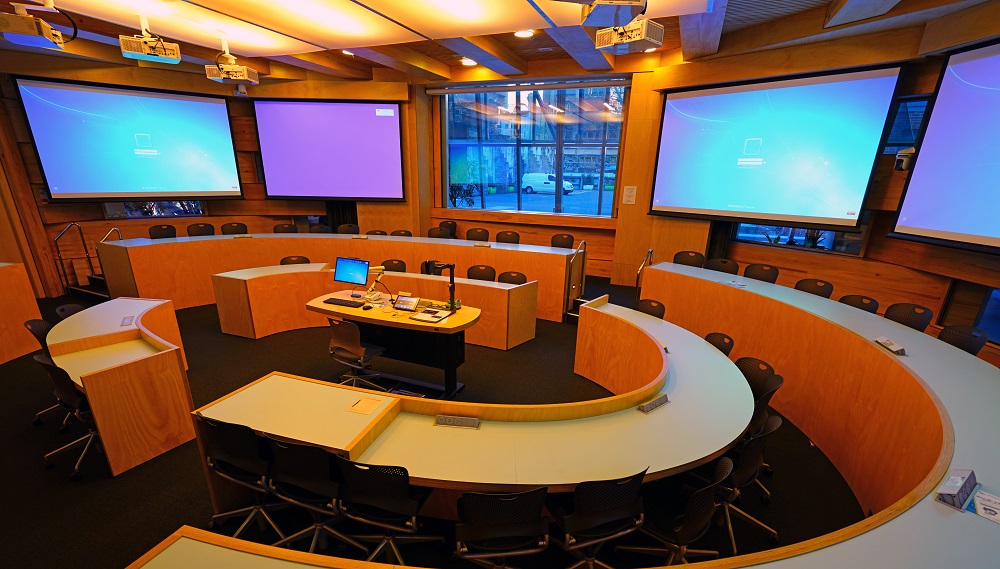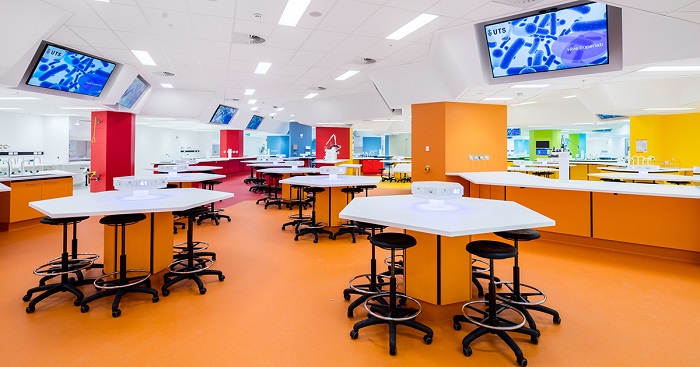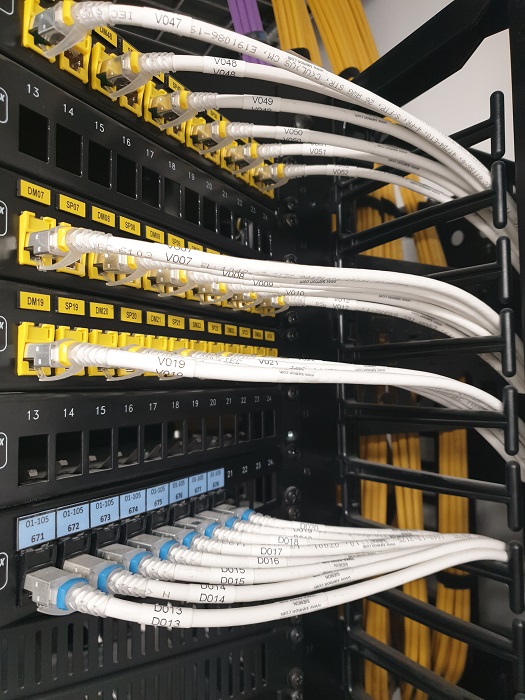One of the largest universities in Australia with an enrolment of more than 44,000 students, the University of Technology Sydney (UTS) is a public university of technology located in the heart of Sydney. While the striking architecture around campus has received much attention and accolades, it’s the benchmark audio-visual (AV) deployments that have truly brought to life UTS’ innovative teaching, learning and social spaces.
UTS has embraced structured cabling for AV since 2010—driven by a strong forward-thinking AV team in conjunction with high-quality infrastructure solutions from a like-minded industry leading partner.
A Better Way to Connect
Connecting the university AV system over network cabling eliminated the need for costly, often difficult-to-install proprietary AV cabling systems, saving on material, labor, and maintenance.
It also better facilitates centralized control, enhances flexibility and scalability, and provides the potential for integration with other IP-based applications.
Because structured cabling has advanced to support high-speed gigabit Ethernet and beyond, it also enables the transmission of ultra-high definition 4K video signals that deliver a better viewing experience with sharper, crisper images and greater colour depth, as well as the transmission of audio and AV control signals.
“Several years ago, there was a need for UTS to standardize on a single cable technology for efficiency and flexibility. Adopting the same structured cabling approach used for the IT network has provided a modular solution that gives us the ability to design, build and test AV systems off site and then simply patch into the installed infrastructure. Not only is this a huge time saver that prevents the disruption involved in building and configuring university AV systems on site, but it also allows us to develop standard building blocks for the design and implantation of future AV projects,” says Aaron Costello, manager of audio-visual services (AVS) projects for UTS.
“Our approach is in line with what the AV industry is now doing on a wider scale, and we’ve been able to easily shift from Crestron’s DM [digital media] system to the Crestron NVX AVoIP solution because we have structured cabling in place to support it.”
AV over IP minimizes traditional point-to-point cabling and allows for connecting any AV device to any outlet, providing UTS with flexibility, consistency and cost savings.
For the cabling and connectivity that comprises the Crestron AV systems within campus buildings, UTS standardized on a Siemon’s Z-MAX category 6A shielded system that features high performance margins across all transmission parameters.
The system includes category 6A F/UTP cable, outlets, modular cords, patch panels and work area solutions.
dIn fact, UTS uses the Z-MAX category 6A shielded system for all its IP-based applications throughout campus, including voice, data, Wi-Fi, security and more.
A key advantage to the Z-MAX 6A shielded system is the ability to better support remote power technology like Ethernet (PoE) and power over HDBaseT (POH) that delivers DC power to devices simultaneously with AV signals.
Advancements in technology now allow up to 90W of PoE power and 100 watts of POH power to power a broader range of AV devices, which continues to drive the use of remote powering in these applications.
University AV System Capabilities
Inside the 17-story UTS Central Building 2 is a new 250-seat Superlab that leverages AV technology to allows up to seven classes to operate simultaneously. Referred to as ‘The Hive’ based on its hexagonal learning pods, the lab features strategically located 65-inch monitors set into angled overhead bulkheads that provide a clear view to every space.
Visual signals are also relayed wirelessly to student tablets, allowing them to move freely throughout the space.
dDemonstrator stations use a Crestron DigitalMedia presentation switcher with camera to provide close-up views of experiments that can be pushed out to the student tablets, and sound is distributed to wireless student headsets using Digital Audio Network Through Ethernet (Dante) that transmits digital audio signals over the IP-based network.
Several UTS buildings also features collaborative classrooms that ensure students effectively see and hear the learning materials being presented, enable small-group collaboration and allow each group to present their own work on the displays.
This is achieved through an advanced Crestron AV system with dual-source projection and lecterns that allow for teaching to the entire space or to specific smaller collaboration stations.
Located within the Vicki Sara science building (Building 7), UTS also has a Science Super Lab that was the first of its kind in Australia when it opened in 2014.
It features demonstrator stations equipped with a PC, document camera, microscopes and AV controllers along with 26 workbenches seating 8 students that each have an AV touchscreen and microphone.
The university AV system allows for two-way communication between the demonstrator and the class and content display from any student.
The Data Arena located in the Faculty of Engineering and IT (FEIT) building features a large curved screen four meters high that enables 360-degree 2D and 3D interactive data visualization via multiple in-sync projectors.
Using open-source software to transform numbers into interactive geometry, the Data Arena combines visual effects and data visualization that allows students to interact with visual interpretations of data to gain unique insights into patterns and anomalies that can unlock advances in a variety of fields.
Fully configurable presentation areas and media labs, AV-equipped group study spaces, real-time information displays, and several other AV systems also contribute to ensuring UTS’ innovative teaching, learning and social spaces, as well as enhanced sports and leisure activities for an overall enhanced campus life.
The Power of Partnerships
Project managers for all campus AV projects engage with both departments to ensure that all deployments are done in compliance with university specifications and industry standards.
“AVoIP requires both AV and IT teams to meet regularly, and we have established systems in place with regards to how we share documentation,” says Jonathan Mansfield, IT division project manager for UTS.
“We have consolidated information regarding devices, serial numbers and MAC addresses that lets us see all the information in one place for easier troubleshooting and commissioning of network switches.”
One unique Siemon product that has been ideal for UTS AV deployments is the low-profile multi-user telecommunications outlet assembly (MUTOA) designed to provide up to 18 category 6A connections.
This low-profile surface mount box offers rear or top cable access, space for cable slack while maintaining minimum bend radius and can be mounted to standard electrical boxes.
“The MUTOA has been ideal as a consolidation point at lecterns to connect several devices, including instructor laptops, AV control panels, monitors and document cameras,” says Costello.
One of the components of the Z-MAX system that has been beneficial to UTS is Siemon’s patented Z-MAX 45 shielded category 6A outlet that provides a shorter, compact design with the ability to terminate cable at a 45-degree angle from two different directions.
According to Mansfield, this was especially ideal for tight-fitting spaces such as those used for connecting AV control panels or for connections located in shallow skirting duct (i.e., raceway).
Connections in tight fitting spaces were also eased with Siemon’s SkinnyPatch modular category 6A shielded patch cords that feature a reduced cable diameter using 28AWG stranded copper construction.
“We have meeting scheduling panels outside of conference rooms and study spaces, and the glass walls surrounding these spaces limits the amount of space to connect the devices,” says Costello.
“The SkinnyPatch is an ideal solution for this application since it takes up less space and offers a tighter bend radius.”
UTS has had a relationship with Siemon for about 25 years, and that has continued through multiple tendering processes that are conducted every five-to-six years.
[inpagepromo]









































